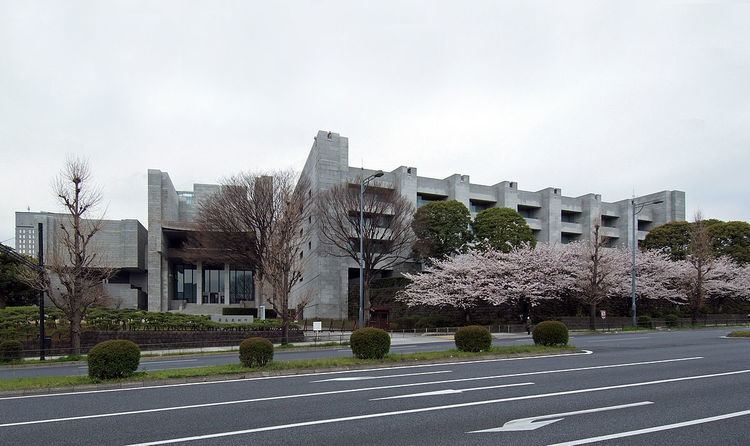Established 1947 Phone +81 3-3264-8111 Currently Itsurō Terada | Website www.courts.go.jp | |
 | ||
Composition method Appointed by The Emperor on the advice of the Prime Minister. Judge term length Life tenure until the mandatory retirement age of 70. Hours Closed today SaturdayClosedSundayClosedMonday8:30AM–5:30PMTuesday8:30AM–5:30PMWednesday8:30AM–5:30PMThursday8:30AM–5:30PMFriday8:30AM–5:30PMSuggest an edit Similar Ministry of Justice, National Diet Library, National Theatre of Japan, Intellectual Property High Court, House of Represen | ||
Supreme court of japan by picua
The Supreme Court of Japan (最高裁判所 Saikō-Saibansho; called 最高裁 Saikō-Sai for short), located in Hayabusachō, Chiyoda, Tokyo, is the highest court in Japan. It has ultimate judicial authority to interpret the Japanese constitution and decide questions of national law (including local bylaws). It has the power of judicial review; that is, it can declare Acts of the National Diet, local assemblies, and administrative actions, to be unconstitutional.
Contents
- Supreme court of japan by picua
- Saik saibansho supreme court of japan
- History
- Appointment and organization
- Judicial review of laws
- Current justices
- References
Saik saibansho supreme court of japan
History
The first Western-style supreme court in Japan was the Supreme Court of Judicature (大審院 Dai-shin'in) organized by the Ministry of Justice in 1875. This court was composed of 120 judges in both civil and criminal divisions. Five judges would be empaneled for any given case. The criminal division of the court was the court of first instance for crimes against the Emperor (e.g. lèse majesté) and for high crimes against public order.
The statute creating the Court was abolished in 1947, and the modern Supreme Court was formed that year under the constitution of 1947. The new court was first convened in May 1947 in the former Privy Council quarters of the Tokyo Imperial Palace. It moved to the Tokyo District Court building in September, then assumed the former quarters of the Supreme Court of Judicature in October 1949.
In 1974, the Supreme Court moved to its current five-story building at 4-2 Hayabusa-cho, Chiyoda, Tokyo. The building was designed by architect Shinichi Okada and won the Architecture Institute of Japan Prize for Design.
Appointment and organization
The Article 81 of the constitution designates it as "the court of last resort with power to determine the constitutionality of any law, order, regulation, or official act." The Supreme Court is also responsible for nominating judges to lower courts, determining judicial procedures, overseeing the judicial system, including the activities of public prosecutors, and disciplining judges and other judicial personnel. It renders decisions from either a grand bench of fifteen justices or a petit bench of five. The grand bench is required for cases involving constitutionality. The court includes 34 research clerks, whose function is similar to that of the clerks of the United States Supreme Court.
The Chief Justice is nominated by the Cabinet and appointed to office by the Emperor.
The associate justices are appointed by the Cabinet in attestation of the Emperor.
After appointment, Supreme Court justices are subject to a "people's review": an automatic retention referendum in which the voters may remove the judge from office. A people's review occurs at the first election to the House of Representatives after a justice assumes office, when the question of whether his tenure should continue is put to voters on the ballot. The Supreme Court justice is then subject to a further people's review at the first lower house election after every ten years. The system used resembles the Missouri Plan followed in some U.S. states. It is established by Article 79 of the constitution which includes the following provisions:
As of October 2009, no Supreme Court justice has ever been dismissed by a people's review. It is also unusual for a justice to be subject to a second review, as most are over the age of sixty when appointed and there is mandatory retirement at seventy.
Judicial review of laws
The Supreme Court is the only Japanese court explicitly empowered to review the constitutionality of laws, although it has held that lower courts also have power to interpret the constitution. Unlike constitutional courts in other civil law countries, it only exercises judicial review in cases where there is a genuine dispute between parties, and does not accept questions of constitutionality from government officials.
The Supreme Court is generally reluctant to exercise the powers of judicial review given to it by the constitution, in large part because of unwillingness to become involved in politically sensitive issues. When decisions have been rendered on such matters as the constitutionality of the Self-Defense Forces, the sponsorship of Shinto ceremonies by public authorities, or the authority of the Ministry of Education to determine the content of school textbooks or teaching curricula, the Court has generally deferred to the government.
One important exception to this trend was a series of rulings on the unconstitutionality of the electoral district apportionment system. Although the Court ruled in 1964 that legislative districting was largely a matter of legislative policy, it ruled in the 1976 case of Kurokawa v. Chiba Prefecture Election Control Commission, that a 5:1 discrepancy in the voter-to-representative ratio between two districts was an unconstitutional violation of the right to an equal vote. Nonetheless the Diet has repeatedly failed to keep malapportionment within the limits set forth in Kurokawa. Aside from electoral matters, provisions declared unconstitutional by the Supreme Court have included rules
One critic of the court writes that:
Current justices
The current justices are:
